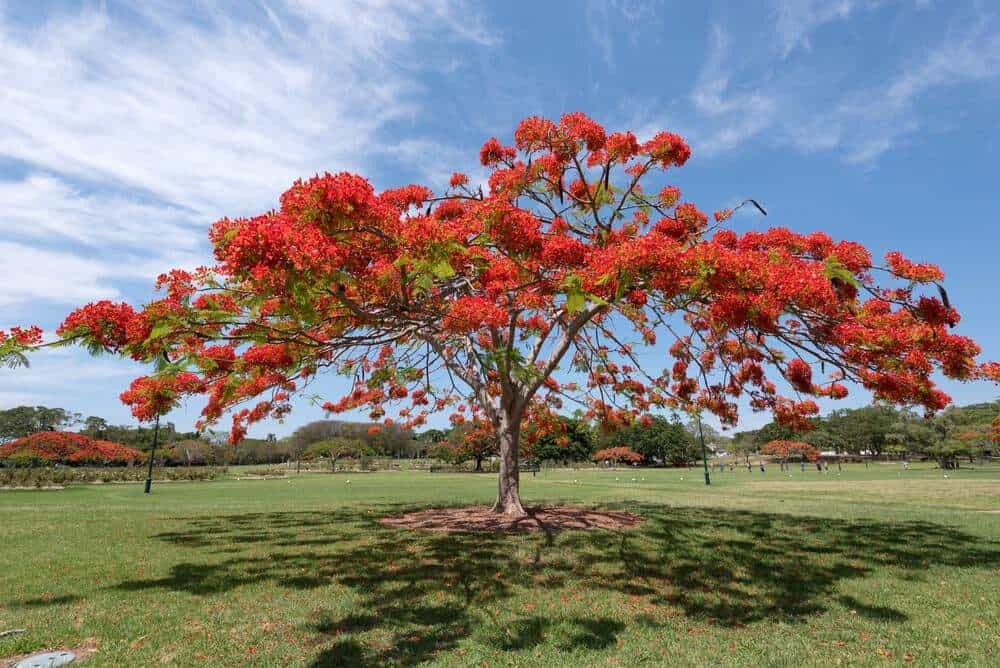You know summer is here when the roads and parks are full of bright orange and red flowers. The Royal Poinciana tree begins flowering to start the season.
In both old and new suburbs, this ‘flamboyant tree’ lights up the view.
Royal Poinciana (delonix regia) were traditionally planted as street trees, so now their wide canopies shade the sidewalks and rain red petals down on passersby.
But you can also enjoy the beauty of this flowering tree right in your garden!
Need a guide for how to grow a Royal Poinciana tree and care for it? Read on!
Royal Poinciana Tree Facts
There’s a lot to know about this flamboyant tree that has shaped Brisbane and other cities around Australia.
The Poinciana tree (delonix regia) is actually native to Madagascar. It has since become naturalised in many other countries, such as around equatorial Asia, China, and Australia.
This semi-deciduous and evergreen tree is the perfect ornamental focal point for a garden — but not small ones! Their average height is 3–5m, while some can grow up to 10m tall.
And of course, there are the iconic red petals that blanket the tree in the summer, adding the perfect pop of colour to any backyard.
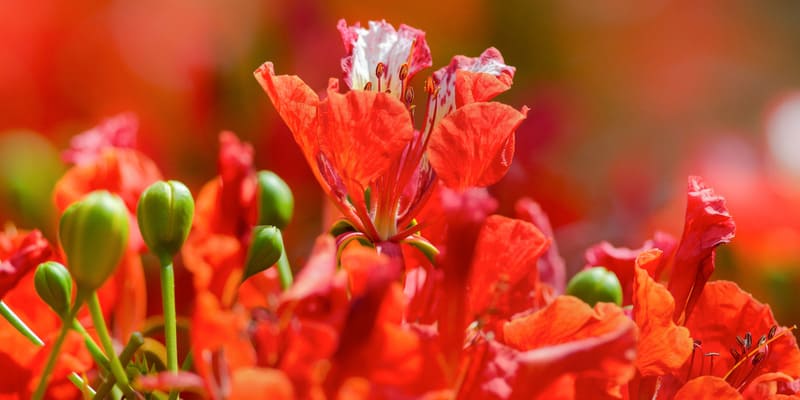
Is Royal Poinciana a flame tree? It’s certainly called that, as well as flamboyan tree, gold mohar, red tree, and peacock flower.
But it’s entirely different from the Illawarra flame tree besides the striking colour of its flowers. Don’t confuse the two, especially when planting!
It’s also important to note that the Royal Poinciana is a fast-growing tree, at least 1.5m each year.
It doesn’t live long, however — its lifespan rarely exceeds 40 years. But while it’s in good health, it provides a fantastic crimson canopy to show off in your garden, the perfect representation of summer warmth.
Growing Royal Poinciana
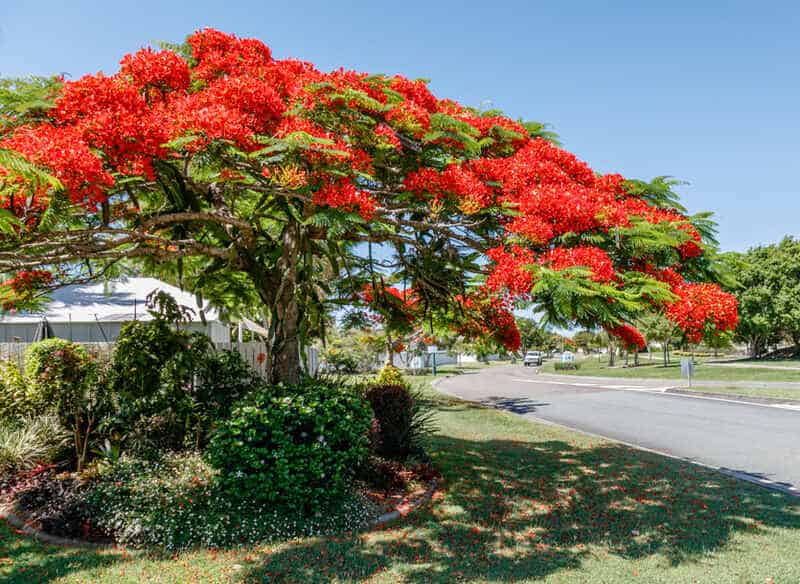
When growing Royal Poinciana in your garden, there are several important factors to take note of, particularly regarding their roots and their foliage.
Proximity
Royal Poinciana trees have ‘buttress roots’, which often extend close to or past the surface. They could damage sidewalks and roads, or suffer damage from cars, if planted too close.
The same goes for structures on your property, especially houses.
If you have pools or ponds on your property, it’s not recommended to plant a Poinciana tree nearby either — the leaves and flowers will get into your filter, and it’ll be a pain to clean them out!
Climate
Royal Poinciana trees thrive in tropical and subtropical climates, given their native habitat.
They’ll grow best in full sun, and can tolerate both drought and salt. However, they’re very sensitive to cold, and cannot survive anywhere that gets frost.
In Australia, Poinciana trees will cultivate best in Zones 1 to 4.
Soil
The Royal Poinciana tree prefers free-draining soil, usually of a sandy or loamy type.
Avoid heavy or clay soils since these retain more moisture, and the Poinciana flowers better when kept slightly dry. You’ll want to aim for a high pH — generally about 6.5-7.0.
Pods

The long, woody pods of a Poinciana are actually legumes, and are the tree’s ‘fruit’. They average 30-45cm in length, and about 5cm wide.
They’re great for the tree, but not so much for tree owners. Poinciana tree seed pods fall every spring, and pose an extra challenge for gardeners. So when September rolls around, be ready to rake!
Pets
If you’ve got fur friends at home, this tree may not be for you. The seeds and seed pods of Royal Poinciana are toxic to dogs and cats, and can poison them if ingested.
If you do have pets, make sure to rake up pods regularly so your fur friends don’t eat them.
Symptoms of Poinciana poisoning in animals include vomiting, pawing at the mouth, excessive drooling, difficulty swallowing, and mouth irritation.
Planting Royal Poinciana
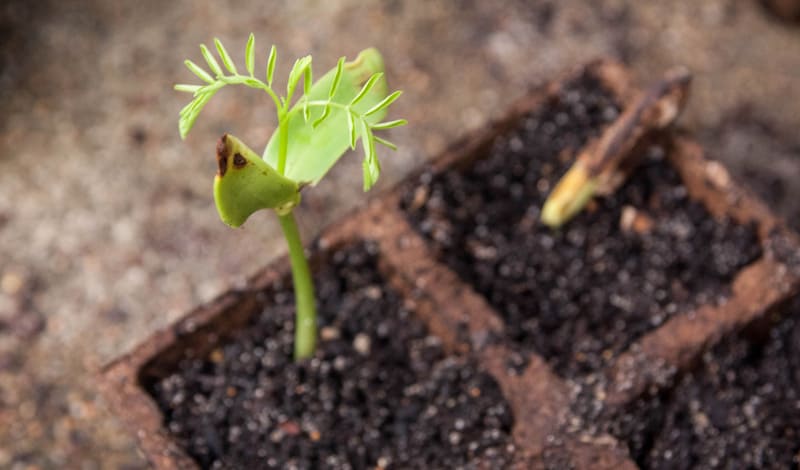
If you’re planting a Royal Poinciana Tree in your yard, you’d better have patience — when grown from seed, they can take up to 10 years to flower.
But the stunning red display is well worth the wait and the effort, so here’s how to grow Royal Poinciana in your garden.
How to grow a Poinciana tree from seed
- To gather seeds, you can simply harvest one of the long seed pods off the ground around a Royal Poinciana tree. Make sure it’s naturally cracked open — that means the seeds are ready for planting.
- You’ll need to germinate the seeds, which involves softening the seed coat. Soak the seeds in warm water for a day so the coat becomes pliable.
- ‘Scarify’ each seed by gently nicking one end with the knife. This will allow water into the seed and speed up the germination process.
- Spread high quality, well draining potting mix onto a seed tray — about 8cm worth. You can also opt for a mix of garden soil, compost, and sand. Just don’t use straight potting soil, as this will be too heavy.
- Take the seeds and sow them 2.5cm deep and 8cm apart. Firm the soil around each seed to ensure good contact. Poinciana seeds are small, so be careful! Then place them somewhere warm and partially shaded.
- Keep the soil consistently moist but not over-damp. The seedlings will need regular watering while they develop, but you don’t want to drown them either.
- Seeds typically germinate in 5-6 weeks. When they reach 20cm in height, you can transfer them to a larger pot. Continue repotting until established, then transplant to your garden and water regularly until they begin to mature.
How to propagate Royal Poinciana
If you’re able, take several 30cm long sections of a Royal Poinciana tree branch. Dust the ends with a rooting hormone to help the cutting grow roots.
Then plant the cuttings about 10cm deep in the ground, and water regularly until established.
Poinciana Tree Care
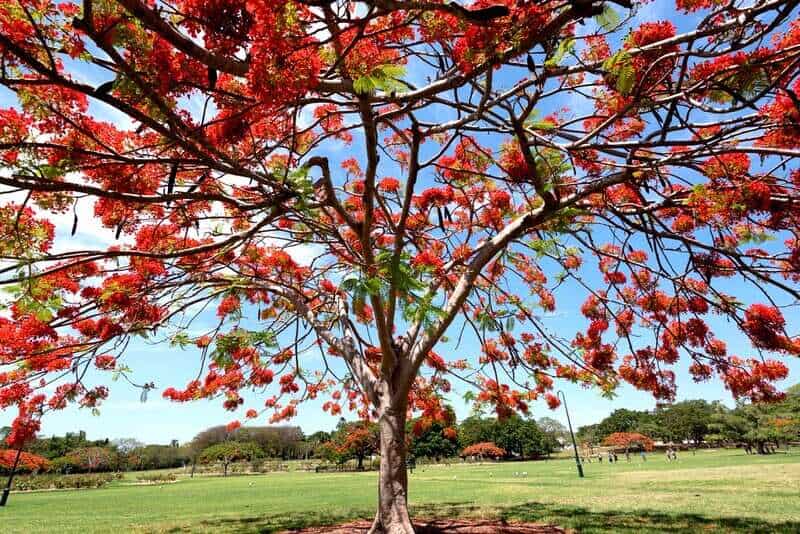
Watering
While your Royal Poinciana establishes roots, it needs regular watering during spring, summer, and early fall.
It’s important that the ground is moist but never over-watered. You can gradually slow down the watering from late fall to winter, at which point you can stop altogether.
Once established, water when the soil gets too dry or if it’s dry and hot outside. Worry not, as the Royal Poinciana tree is drought tolerant. Your tree will flower better when conditions are more dry!
Pruning
This is one aspect where you’ll need to take the most care when maintaining your Poinciana tree. Pruning must be done regularly since the tree’s branches can break easily in strong winds.
Furthermore, it’s important to prune carefully since the tree is susceptible to termites and borers.
As such, pruning and maintenance is better left off to a professional trimming service, which can ensure your tree stays in the best of health!
Fertilising and mulch
You can use a phosphatic fertiliser to aid the growth process and give your Poinciana tree a boost during the flowering season. Granular forms are best, and should be applied in spring and autumn.
As for mulch, layer organic matter around the base, but not too close to the trunk!
This will also help retain moisture and let your tree go longer between watering. And if you’re using wood chips, don’t place ones longer than 25mm — this could encourage fungus on the roots.
Pests
The Royal Poinciana tree is susceptible to borers, which also target Australian native trees.
Check your tree regularly for borer holes — pin-holes underneath peeling and damaged bark.
If you find any, get your tree treated immediately; the Poinciana could collapse from the resulting rot.
Com-plant-nions
With its wide canopy and lush foliage, the Poinciana tree will shade the ground underneath it.
Consider growing shade-loving plants underneath, or groundcover such as ajuga, lilyturf, and mondo grass.

